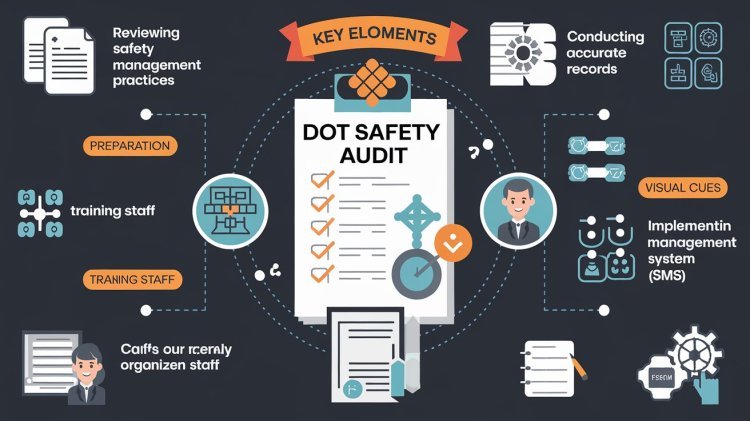How to Pass DOT Safety Audit: A Comprehensive Guide
This article offers a guide on passing a DOT safety audit, covering essential preparation steps like reviewing safety practices, maintaining accurate records, conducting internal audits, training staff, and implementing a Safety Management System (SMS). It emphasizes the importance of organization, cooperation with the auditor, and note-taking during the audit. Afterward, it stresses reviewing findings, making improvements, and maintaining ongoing compliance to foster a safety culture in the organization.

Navigating the complexity of a Department of Transportation (DOT) safety audit can be difficult for fleet operators and transportation corporations. A good audit not only ensures compliance, but it also improves safety and operational efficiency. This is a complete guide on preparing for and passing a DOT safety audit.
Understanding the DOT Safety Audit
A DOT safety audit is an assessment performed by the Federal Motor Carrier Safety Administration (FMCSA) to ensure that commercial vehicle operators follow federal safety rules. The audit assesses several aspects, including:
- Driver Qualifications: Ensuring that all drivers have valid licenses and meet health requirements.
- Vehicle Maintenance: Checking that vehicles are regularly inspected and maintained.
- Hours of Service (HOS) Compliance: Verifying that drivers adhere to regulations regarding driving hours and rest periods.
- Recordkeeping: Ensuring all necessary documentation is accurate and up-to-date.
Steps to Prepare for a DOT Safety Audit
1. Review Your Safety Management Practices
Before the audit, assess your current safety management practices. Ensure you have established protocols for:
- Driver training and certification
- Vehicle maintenance schedules
- Incident reporting and response procedures
2. Maintain Accurate Records
Documentation is crucial for a successful audit. Make sure you have the following records readily available:
- Driver qualification files
- Maintenance and inspection records
- HOS logs
- Accident reports
Ensure all records are complete, accurate, and easily accessible.
3. Conduct Internal Audits
Regularly perform internal audits to identify any compliance gaps. This proactive approach allows you to address issues before the DOT audit. Focus on areas like:
- Driver training programs
- Vehicle inspection and maintenance
- HOS compliance
4. Train Your Staff
Ensure that all employees understand DOT regulations and their responsibilities. Conduct regular training sessions on safety procedures, recordkeeping, and compliance requirements.
5. Implement a Safety Management System (SMS)
Adopting a Safety Management System can help streamline compliance efforts. An SMS provides a structured approach to safety management, allowing for better tracking of performance, incidents, and regulatory requirements.
Request For Sample! https://axonator.com/request-for-demo/
During the DOT Audit
1. Be Prepared and Organized
On the day of the audit, ensure that all necessary documents are organized and readily accessible. This includes:
- Driver qualification files
- Vehicle maintenance records
- HOS logs
A well-organized presentation of your documents can create a positive impression on the auditor.
2. Cooperate with the Auditor
Maintain a positive attitude and cooperate fully with the auditor. Answer questions honestly and provide the requested information promptly. Avoid being defensive; instead, view the audit as an opportunity to improve your safety practices.
3. Take Notes
During the audit, take detailed notes on the auditor’s findings and recommendations. This information is invaluable for making necessary changes to your safety management practices.
After the DOT Audit
1. Review Audit Findings
Once the audit is complete, review the findings and recommendations thoroughly. Address any issues raised by the auditor and develop a plan for corrective actions.
2. Implement Improvements
Use the audit as a learning opportunity. Implement any recommended changes to enhance your safety practices and ensure compliance.
3. Maintain Ongoing Compliance
Passing a DOT safety audit is not a one-time effort. Establish a culture of safety within your organization by continuously monitoring compliance and improving safety management practices.
For More Information! https://axonator.com/blog/how-to-pass-dot-safety-audit/
Passing a DOT safety audit involves meticulous planning, organization, and a dedication to safety. By taking the measures indicated above, you can ensure that your firm meets regulatory standards while also promoting a safety culture. Remember that a successful audit not only protects your business, but also helps to ensure the safety of the entire transportation community.
About Axonator Inc:
At Axonator, Our vision is simple yet powerful: to enable the world on mobile. We envision a future where every aspect of business and society is seamlessly connected through mobile devices. Our mission is to empower businesses worldwide to leverage the full potential of mobile technology, transforming the way they operate, communicate, and collaborate.
Contact:
Axonator Inc. (The World On Mobile)
Austin, TX, USA
USA: +1-716-274-8885
India: +91-8600-032-635
Email: support@axonator.com
Website: https://axonator.com/
What's Your Reaction?

















